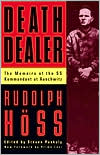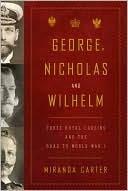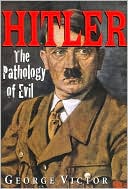Death Dealer
SS Kommandant Rudolph Höss (19001947) was history's greatest mass murderer, personally supervising the extermination of approximately two million people, mostly Jews, at the death camp in Auschwitz, Poland. Death Dealer is a new, unexpurgated translation of Höss’s autobiography, written before, during, and after his trial. This edition includes rare photos, the minutes of the Wannsee Conference (where the Final Solution was decided and coordinated), original diagrams of the camps, a detailed...
Search in google:
SS Kommandant Rudolph Höss (1900–1947) was history's greatest mass murderer, personally supervising the extermination of approximately two million people, mostly Jews, at the death camp in Auschwitz, Poland. Death Dealer is a new, unexpurgated translation of Höss’s autobiography, written before, during, and after his trial. This edition includes rare photos, the minutes of the Wannsee Conference (where the Final Solution was decided and coordinated), original diagrams of the camps, a detailed chronology of important events at Auschwitz-Birkenau, Höss's final letters to his family, and a new foreword by Auschwitz survivor Primo Levi. Death Dealer stands as one of the most important—and chilling—documents of the Holocaust. Publishers Weekly This first complete English translation of a senior Nazi officer's account of the Final Solution describes in cold, stomach-churning detail the program of genocide as an administrative procedure. Written during the six months before his 1947 execution in Warsaw for ``crimes committed against the Polish people,'' Hoss's memoirs are filled with specific recollections, from his fervently religious boyhood in Mannheim, through a prison term in Liepzig (for having killed a fellow soldier), to marriage and induction into the SS in 1934. Particulars of his roles in the concentration camp system include his ordering of ``the first execution of the war'' at Sachsenhausen in 1938 and his 1941 assignment to establish and manage Auschwitz as ``the largest human killing center in all of history.'' Personal squabbles with other SS leaders are interspersed with chilling descriptions of prison conditions and gassing procedures. This compelling historical document, from which Hoss emerges as a classic model of the bureaucratic middle manager, is expertly edited by Paskuly, a history teacher in New York; Pollinger's translation is seamless. Photos not seen by PW. (Apr.)
Foreword3Preface11Acknowledgments15Translator's Note17Introduction191The Final Solution of the Jewish Question in Concentration Camp Auschwitz272Early Years483An Early Traumatic Experience524World War I545Battles of the Free Corps606On Trial for Murder627In Prison648Insights into the Criminal Mind679Prison Psychosis7210Model Prisoner7511Freedom7712The Artamans7913Again a Soldier8114The Early Concentration Camps8515The Types of Guards8816Experiences in Sachsenhausen9717Kommandant of Auschwitz11818The Russian Prisoners of War13219The Gypsies13520The Jews13921The Women's Camp14522The Gassings15523Chief of the Department of Inspections of Concentration Camps165241945-4717825Some Final Thoughts18226Final Letters to His Wife and Children18927Epilogue19628Rules and Regulations for Concentration Camps209Purpose of the Camps209Organization of the Concentration Camps209Camp Punishments218Work Deployment219The Non-Medical Activities of the SS Doctors in Auschwitz22329Organization Schmelt22930Night and Fog - Meerschaum32631Lebensborn32732Explanation of the Three Concurrent SS Ranks33033SS Tattoos332Appendix IIncident at Budy333Appendix IIChronology of the Important Events at Auschwitz-Birkenau336Appendix IIIWannsee Conference Minutes371Bibliography383Index387
\ Publishers Weekly - Publisher's Weekly\ This first complete English translation of a senior Nazi officer's account of the Final Solution describes in cold, stomach-churning detail the program of genocide as an administrative procedure. Written during the six months before his 1947 execution in Warsaw for ``crimes committed against the Polish people,'' Hoss's memoirs are filled with specific recollections, from his fervently religious boyhood in Mannheim, through a prison term in Liepzig (for having killed a fellow soldier), to marriage and induction into the SS in 1934. Particulars of his roles in the concentration camp system include his ordering of ``the first execution of the war'' at Sachsenhausen in 1938 and his 1941 assignment to establish and manage Auschwitz as ``the largest human killing center in all of history.'' Personal squabbles with other SS leaders are interspersed with chilling descriptions of prison conditions and gassing procedures. This compelling historical document, from which Hoss emerges as a classic model of the bureaucratic middle manager, is expertly edited by Paskuly, a history teacher in New York; Pollinger's translation is seamless. Photos not seen by PW. (Apr.)\ \ \ \ \ Library JournalThe man who presided over the expansion and lethal functioning of Auschwitz concentration camp, which surely earned him the distinction of being ``the greatest destroyer of human beings in history,'' left behind this memoir before he was executed by the Poles at the end of World War II. A dedicated bureaucrat, Hoss smothered his feelings and devoted his talents to the killing of millions, even though he ``personally never hated the Jews.'' The work was hard, and he ``was no longer happy at Auschwitz once the mass annihilation began.'' An editorial glossary of terms and personalities enhances the usefulness of this valuable addition to Holocaust studies, a chilling self-portrait of an all-too-typical servant of totalitarianism.-- R.H. Johnston, McMaster Univ., Hamilton, Ontario\ \








